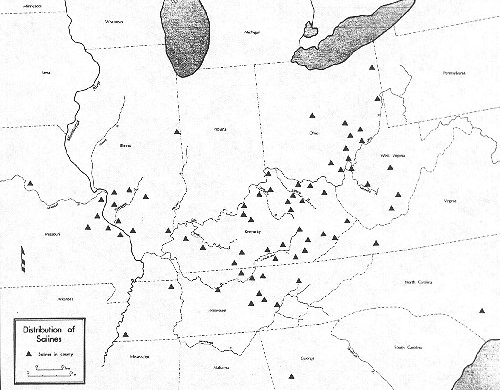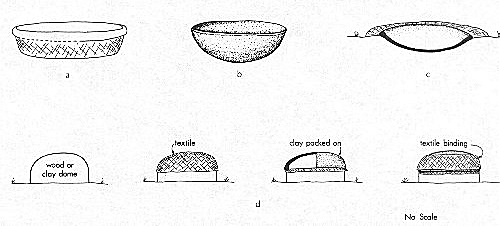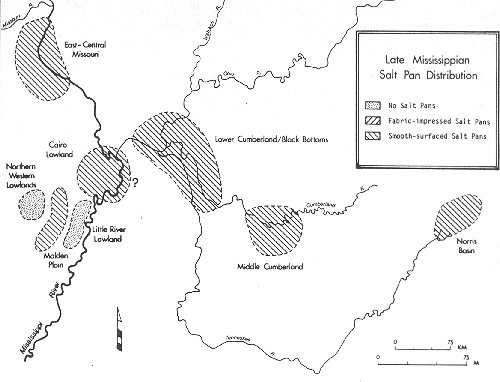The following article was produced by the state of Louisiana as a data project in archaeology. The study can be found at http://www.crt.state.la.us/dataprojects/archaeology/virtualbooks/SALT/hist.htm
There are a number of ways by which salt can be produced, but in Eastern North America Indians obtained most of their salt from salines located far from the coast. A few groups, such as the Chitimacha Indians of Louisiana, did indeed boil seawater, but this practice was rare in Eastern North America as a whole. The early Spanish explorers frequently observed the production and trade of salt in the East. While in the province of Cofitachequi, Hernando DeSoto was given “an abundance of very good salt” (Ranjel in Bourne 1904, 11:99). Similarly, when he was among the Capaha in the Lower Mississippi Valley, he met some Indian merchants who were traveling throughout the various provinces selling salt and other merchandise. These merchants must have had a fairly successful business, because when salt was absent, the effects could be very severe:
“Some of those whose constitutions must have demanded salt more than others died a most unusual death for lack of it. They were seized with a very slow fever, on the third or fourth day of which there was no one at fifty feet could endure the stench of their bodies, it being more offensive than that of the carcasses of dogs or cats. Thus they perished without remedy, for they were ignorant as to what their malady might be or what could be done for them since they had neither physicians nor medicines. And it was believed that they could not have benefited from such had they possessed them because from the moment they first felt the fever, their bodies were already in a state of decomposition. Indeed, from the chest down, their bellies and intestines were as green as grass” (Garcilaso de la Vega 1951:421).
The DeSoto expedition observed the actual production of salt in the provinces of Cayas, Chaguate, and Aguacay. The province of Naguatex, another area mentioned by the expedition chroniclers, was located in what is now northwestern Louisiana. The term Naguatex means “place of salt” in the Caddo language (Swanton 1946). The salt springs of western Arkansas and northwestern Louisiana were well-known to the eighteenth century Indians, and many groups frequented these areas to produce and trade salt. This mineral was extremely important in the trade between the French and the various Caddoan groups (Webb and Gregory 1978). Other Lower Mississippi Valley groups heavily involved with the salt trade were the Quapaw, Koroa, Taensa, and Tunica. Jeffrey P. Brain (1977) has &gued that the Thnica were the principal middlemen in the movement of salt from the Caddoan peoples to the French.
The Indians of Eastern North America apparently used salt as a condiment. There is no evidence for salt ever having been used historically for preserving meat or fish, as drying game over a low fire was the standard Southeastern method of preservation. The DeSoto expedition observed four ways in which salt was produced. It was made from the ashes of plants, from brine water at salines, and from salt-impregnated sand; and it was also gathered in a free state (rock salt). Elvas provided an excellent description of the process of obtaining salt from sand:
“The salt is made along by a river, which, when the water goes down, leaves it upon the sand. As they cannot gather the salt without a large mixture of sand, it is thrown together into certain baskets they have for the purpose, made large at the mouth and small at the bottom. These are set in the air on a ridge-pole; and water being thrown on, vessels are placed under them wherein it may fall; then, being strained and placed on the fire, it is boiled away, leaving salt at the bottom” (Elvas in Bourne 1904, 1:136).
Although salt was in deed extracted from salt-impregnated sand and from the ashes of certain salt plants, it was most commonly produced at brine springs. The Louisiana Indians certainly had numerous springs at their disposal for obtaining salt. A major rock salt deposit, called the Gulf Coast Basin, lies deeply buried beneath the soils of northwest Louisiana and southwest Arkansas (Figure 1). Prehistorically and historically, rich brine came to the surface in these areas. These salines were particularly common along the Red River and the Ouachita River, being found in the parishes listed in Figure 2. Some of the more important salines, operated by Anglo-Americans during the nineteenth century, were Drake’s Salt Works, Price’s Lick, Rayburn’s Salt Works, and King’s Salt Works (Veatch 1902). There was also an excellent saline in the vicinity of Catahoula Lake in LaSalle Parish, and brine springs were quite common along the Sabine River on the Louisiana/Texas border. The most important saline, in terms of the history of the salt industry in the United States, existed on the Avery Island salt dome (Gagliano 1967).
Another extensive salt deposit, called the Salina Basin, underlies the states bordering the Great Lakes. The salines which emerge in Illinois, Missouri, Kentucky, Ohio, New York, West Virginia, Tennessee, and Virginia are located along the margins of this major rock salt deposit (Figures 1 and 3). Some of the most important ones used prehistorically by Indians, and historically by Anglo-Americans, were the famous salines of Ste. Genevieve and Jefferson counties, Missouri, and those at Equality and Shawneetown in Illinois. The Blue Licks and Big Bone Lick in Kentucky, the Big Buffalo Lick in West Virginia, and the French Lick in Tennessee, were other salines of great importance.

Overall, the Indians of the Eastern Woodlands had a goodly number of springs available to obtain their salt, especially if they lived in northwest Louisiana, east-central Missouri, southeast Illinois, eastern Kentucky, or northern Tennessee. But the Mississippian-related cultures of the other Eastern states had to get their salt through trade.


The principal artifact identified with the prehistoric salt industry in Eastern North America is the salt pan. Fragments of these shell-tempered vessels have been found at most salines in the Midwest (Figure 4). There are two types of salt pans. The first has fabric impressions adorning its exterior surface, while the second type is smooth-surfaced (Figure 5a-b). The latter sometimes has a red slip also. Both of these vessels are quite large, averaging between 20 and 30 inches in diameter. Curiously, neither of these two salt pan types is commonly found at salines in Louisiana.


Salt pans are believed to have been used as follows. First they were set within depressions in the ground. Brine was carried from the spring and poured into the pans, followed by heated stones from nearby fires. After evaporation of the water, crystallized salt would then be scraped from the bottom of the containers. There are two theories as to how the fabric-impressed salt pans were constructed. One idea is that the pans were actually made within basins in the ground, textiles having been used to lift the vessels out of their earthen molds (Figure 5c). The other theory is that the vessels were made upside down on wooden or clay molds (Figure 5d). Such procedures, however, do not explain the construction of the smooth-surfaced vessels. There were probably a number of different ways by which large salt pans could have been formed. Regardless of how they were made, smooth-surfaced pans appear to have been an improvement over the fabric-impressed type because textiles were no longer needed in their construction.
Salt pans themselves have been found throughout a large portion of Eastern North America (Figure 6). Although the two types of pans were used at the same time in some areas, there was an increasing tendency to use the smooth-surfaced pan. The distribution of the two types is depicted in Figure 7, and is broken down into early and late Mississippian times in Figures 8 and 9. It can be seen quite clearly that the fabric-impressed salt pan had a greater distribution early in the Mississippi period, the smooth-surfaced type being common only in east-central Missouri and certain portions of southeast Missouri /northeast Arkansas. By late Mississippian times, the smooth-surfaced pan had succeeded the fabric-impressed type over most of the East, but for some reason it was no longer being made in some of the areas where it originated.
The spread of the various salt pan types is not a reflection of mass migrations. It is probable that the idea of salt pans diffused as the different populations recognized the value of the large vessels and learned the techniques involved in making them. But something happened in southeast Missouri /northeast Arkansas in late Mississippian times. The Malden Plain, the Little River Lowland, and the Western Lowlands were populated, yet for some reason smooth-surfaced salt pans were no longer being produced, at least not in the quantities of earlier times. A similar decline in salt pan use has been noted in the very latest prehistoric occupations of other regions in the East. One interpretation is that salt production was no longer an important endeavor. This reason may indeed be a valid explanation for some areas, but it does not adequately explain why, if the production of salt was declining, it was still of such vital importance in the economies of many historic Indian groups. Another possibility is that new processes were involved in the production of salt, processes which have a low archaeological profile, as compared to the earlier abundant salt pan debris. The by-products may perhaps be of an as yet unrecognized nature. To obtain an idea as to what by-products might have occurred, we must look to archaeological production studies in areas where this subject has attracted considerable attention.



